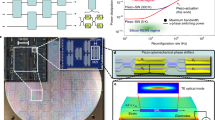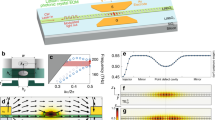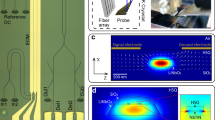Abstract
Photonic integrated circuits (PICs) operating at cryogenic temperatures are fundamental building blocks required to achieve scalable quantum computing and cryogenic computing technologies1,2. Silicon PICs have matured for room-temperature applications, but their cryogenic performance is limited by the absence of efficient low-temperature electro-optic modulation. Here we demonstrate electro-optic switching and modulation from room temperature down to 4 K by using the Pockels effect in integrated barium titanate (BaTiO3) devices3. We investigate the temperature dependence of the nonlinear optical properties of BaTiO3, showing an effective Pockels coefficient of 200 pm V−1 at 4 K. The fabricated devices show an electro-optic bandwidth of 30 GHz, ultralow-power tuning that is 109 times more efficient than thermal tuning, and high-speed data modulation at 20 Gbps. Our results demonstrate a missing component for cryogenic PICs, removing major roadblocks for the realization of cryogenic-compatible systems in the field of quantum computing, supercomputing and sensing, and for interfacing those systems with instrumentation at room temperature.
This is a preview of subscription content, access via your institution
Access options
Access Nature and 54 other Nature Portfolio journals
Get Nature+, our best-value online-access subscription
$29.99 / 30 days
cancel any time
Subscribe to this journal
Receive 12 print issues and online access
$259.00 per year
only $21.58 per issue
Buy this article
- Purchase on Springer Link
- Instant access to full article PDF
Prices may be subject to local taxes which are calculated during checkout




Similar content being viewed by others
Data availability
The data from the electro-optic measurements analysed and presented in Figs. 2a–c, 3 and 4 are available in an online repository with the digital object identifier: https://doi.org/10.5523/bris.3dwflddsnkun32ghpq4zufxtl1. The remaining data supporting the findings of this study are available from the corresponding author upon reasonable request.
References
Silverstone, J. W., Bonneau, D., O’Brien, J. L. & Thompson, M. G. Silicon quantum photonics. IEEE J. Sel. Top. Quantum Electron. 22, 6700113 (2016).
O’Brien, J. L., Furusawa, A. & Vučković, J. Photonic quantum technologies. Nat. Photon. 3, 687–695 (2009).
Abel, S. et al. Large Pockels effect in micro- and nanostructured barium titanate integrated on silicon. Nat. Mater. 18, 42–47 (2019).
Mukhanov, O. A. Energy-efficient single flux quantum technology. IEEE Trans. Appl. Supercond. 21, 760–769 (2011).
Ladd, T. D. et al. Quantum computing. Nature 464, 45–53 (2010).
Zeghbroeck, B. Van Optical data communication between Josephson-junction circuits and room-temperature electronics. IEEE Trans. Appl. Supercond. 3, 2881–2884 (1993).
Kimble, H. J. The quantum internet. Nature 453, 1023–1030 (2008).
Javerzac-Galy, C. et al. On-chip microwave-to-optical quantum coherent converter based on a superconducting resonator coupled to an electro-optic microresonator. Phys. Rev. A 94, 053815 (2016).
Greganti, C., Roehsner, M. C., Barz, S., Morimae, T. & Walther, P. Demonstration of measurement-only blind quantum computing. New J. Phys. 18, 303–309 (2016).
Mehta, K. K. et al. Integrated optical addressing of an ion qubit. Nat. Nanotechnol. 11, 1066–1070 (2016).
Johnston, A. R. et al. Optical links for cryogenic focal plane array readout. Opt. Eng. 33, 2013–2019 (1994).
Dowell, J. D. et al. Optoelectronic Analogue Signal Transfer for LHC Detectors CERN/DRDC-91-41 (CERN, 1991).
Benea-Chelmus, I.-C., Settembrini, F. F., Scalari, G. & Faist, J. Electric field correlation measurements on the electromagnetic vacuum state. Nature 568, 202–206 (2019).
Elshaari, A. W., Zadeh, I. E., Jöns, K. D. & Zwiller, V. Thermo-optic characterization of silicon nitride resonators for cryogenic photonic circuits. IEEE Photon. J. 8, 2701009 (2016).
Gehl, M. et al. Operation of high-speed silicon photonic micro-disk modulators at cryogenic temperatures. Optica 4, 374–382 (2017).
Harris, N. C. et al. Efficient, compact and low loss thermo-optic phase shifter in silicon. Opt. Express 22, 83–85 (2014).
Li, Y., Humphreys, P. C., Mendoza, G. J. & Benjamin, S. C. Resource costs for fault-tolerant linear optical quantum computing. Phys. Rev. X 5, 41007 (2015).
Pintus, P. et al. Characterization of heterogeneous InP-on-Si optical modulators operating between 77 K and room temperature. APL Photon. 4, 100805 (2019).
Alexander, K. et al. Nanophotonic Pockels modulators on a silicon nitride platform. Nat. Commun. 9, 3444 (2018).
Wang, C. et al. Integrated lithium niobate electro-optic modulators operating at CMOS-compatible voltages. Nature 562, 101–104 (2018).
Eltes, F. et al. Low-loss BaTiO3-Si waveguides for nonlinear integrated photonics. ACS Photon. 3, 1698–1703 (2016).
Herzog, C., Poberaj, G. & Günter, P. Electro-optic behavior of lithium niobate at cryogenic temperatures. Opt. Commun. 281, 793–796 (2008).
Lauermann, M. et al. 40 GBd 16QAM signaling at 160 Gb/s in a silicon-organic hybrid modulator. J. Light. Technol. 33, 1210–1216 (2015).
Eltes, F. et al. A BaTiO3-based electro-optic Pockels modulator monolithically integrated on an advanced silicon photonics platform. J. Lightwave Technol. 37, 1456–1462 (2019).
Kay, H. F. & Vousden, P. XCV. Symmetry changes in barium titanate at low temperatures and their relation to its ferroelectric properties. Lond. Edinb. Dublin Phil. Mag. J. Sci. 40, 1019–1040 (1949).
He, F. & Wells, B. O. Lattice strain in epitaxial BaTiO3 thin films. Appl. Phys. Lett. 88, 152908 (2006).
Tenne, D. A. et al. Absence of low-temperature phase transitions in epitaxial BaTiO3 thin films. Phys. Rev. B 69, 2–6 (2004).
Bernasconi, P., Zgonik, M. & Gunter, P. Temperature dependence and dispersion of electro-optic and elasto-optic effect in perovskite crystals. J. Appl. Phys. 78, 2651–2658 (1995).
Acosta, M. et al. BaTiO3-based piezoelectrics: fundamentals, current status, and perspectives. Appl. Phys. Rev. 4, 041305 (2017).
Pfeiffer, M. H. P. et al. Ultra-smooth silicon nitride waveguides based on the Damascene reflow process: fabrication and loss origins. Optica 5, 884–892 (2018).
Acknowledgements
This work has received funding from the European Commission under grant agreement numbers H2020-ICT-2015-25- 688579 (PHRESCO) and H2020-ICT-2017-1-780997 (plaCMOS), from the Swiss State Secretariat for Education, Research and Innovation under contract numbers 15.0285 and 16.0001, from the Swiss National Foundation project number 200021_159565 PADOMO, from EPSRC grants EP/L024020/1, EP/M013472/1 and EP/K033085/1, the UK EPSRC grant QuPIC (EP/N015126/1), and ERC grant 2014- STG 640079. J.B. thanks D. Sahin for her assistance with the experimental setup.
Author information
Authors and Affiliations
Contributions
F.E. and J.F. fabricated and structurally characterized the epitaxial BaTiO3/SrTiO3 layer stack with support from H.S. F.E. designed all photonic circuits and fabricated them with support from D.C. F.E., P.S. and S.A. performed optical simulations for the device design. G.E.V.-G., F.E., A.A.G., A.H., G.D.M. and J.B. characterized the electro-optic performance at different temperatures, including low-speed and radiofrequency measurements. The electro-optic data were analysed by F.E. and A.A.G. F.E. and P.S. performed all electrical measurements. The concept for this work was defined by S.A., G.D.M. and M.G.T. and implemented by F.E. with support of S.A. and J.B. F.E., J.F. and S.A. wrote the manuscript with contributions from all authors.
Corresponding authors
Ethics declarations
Competing interests
F.E., J.F. and S.A. are involved in commercially developing barium titanate technologies at Lumiphase AG. M.G.T. is involved in developing photonic quantum technologies at PsiQuantum Corporation.
Additional information
Publisher’s note Springer Nature remains neutral with regard to jurisdictional claims in published maps and institutional affiliations.
Supplementary information
Supplementary Information
Supplementary Notes 1–9, Figs. 1–12, Table 1 and refs 1–14.
Rights and permissions
About this article
Cite this article
Eltes, F., Villarreal-Garcia, G.E., Caimi, D. et al. An integrated optical modulator operating at cryogenic temperatures. Nat. Mater. 19, 1164–1168 (2020). https://doi.org/10.1038/s41563-020-0725-5
Received:
Accepted:
Published:
Issue Date:
DOI: https://doi.org/10.1038/s41563-020-0725-5
This article is cited by
-
Photonic link from single-flux-quantum circuits to room temperature
Nature Photonics (2024)
-
Applications of remote epitaxy and van der Waals epitaxy
Nano Convergence (2023)
-
Deterministic photon source interfaced with a programmable silicon-nitride integrated circuit
npj Quantum Information (2023)
-
Coherent optical control of a superconducting microwave cavity via electro-optical dynamical back-action
Nature Communications (2023)
-
Recent progress in quantum photonic chips for quantum communication and internet
Light: Science & Applications (2023)



